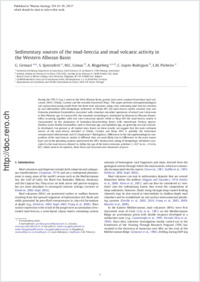Sedimentary sources of the mud-breccia and mud volcanic activity in the Western Alboran Basin
- Gennari, Giordana University of Fribourg, Department of Geosciences, Switzerland
- Spezzaferri, Silvia University of Fribourg, Department of Geosciences, Switzerland
- Comas, M.C. Instituto Andaluz de Ciencias de la Tierra, Armilla, Spain
- Rüggeberg, Andres University of Fribourg, Department of Geosciences, Switzerland - Renard Centre of Marine Geology, Gent University, Belgium - GEOMAR-Hemholtz Centre for Ocean Research Kiel, Germany
- Lopez-Rodriguez, C. Instituto Andaluz de Ciencias de la Tierra, Armilla, Spain
- Pinheiro, L.M. Departamento de Geociências and CESAM, Universidade de Aveiro, Portugal
-
01.05.2013
Published in:
- Marine Geology. - 2013, vol. 339, p. 83–95
English
During the TTR-17 Leg 1 cruise in the West Alboran Basin, gravity cores were acquired from three mud volcanoes (MVs): Dhaka, Carmen and the recently discovered Maya. This paper presents micropaleontological and radiocarbon dating results from the three mud volcanoes, using cores containing mud breccias overlain by and interbedded with hemipelagic sediments. At Dhaka MV, the mud-breccia matrix contains very rare Holocene planktonic foraminifera associated with abundant reworked specimens of mixed Late Cretaceous to Mio-Pliocene age. At Carmen MV, the reworked assemblage is dominated by Miocene to Pliocene foraminifera occurring together with rare Late Cretaceous species while at Maya MV the mud-breccia matrix is characterized by the dominance of Santonian–Maastrichtian forms, with subordinate Tertiary species. Shallow-water benthic foraminifera such as Ammonia spp. and Elphidium spp. are generally rare and randomly distributed, but present at all studied sites. Based on these results, we suggest that the main sediment source of the mud-breccia extruded at Dhaka, Carmen and Maya MVs is possibly the lowermost overpressured olistostromic Unit VI (Aquitanian?–Burdigalian). Differences in the micropaleontological composition of the mud-breccia matrix at different sites are most likely due to differences in the main source layer and in the plumbing systems underneath the MVs. Radiocarbon dating of hemipelagic sediments associated to the mud-breccia allowed to define the age of the latest extrusion activities (> 0.27 ka to > 15.6 ka BP), which seem to be episodic, short-lived and recurrent over thousands of years.
- Faculty
- Faculté des sciences et de médecine
- Department
- Département de Géosciences
- Language
-
- English
- Classification
- Geology
- License
-
License undefined
- Identifiers
-
- RERO DOC 117994
- DOI 10.1016/j.margeo.2013.04.002
- Persistent URL
- https://folia.unifr.ch/unifr/documents/302975
Statistics
Document views: 103
File downloads:
- pdf: 328
